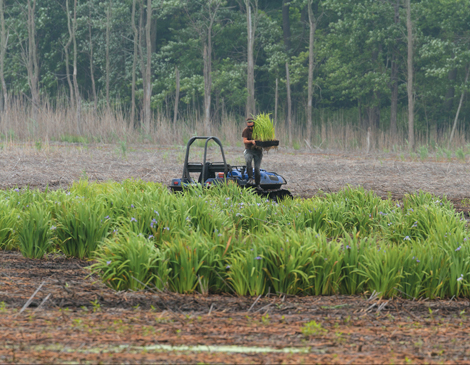
Touring The Mentor Marsh
We hopped in an eight-wheel all-terrain vehicle to take a first-hand look at on-going renovations in the East Side wetland.
The contraption taxis us across the 646-acre state nature preserve, which the museum maintains. Red-winged blackbirds and swallows swoop across our path. Overhead, a bald eagle zooms back to its barrel-sized nest to feed its babies. A turtle slides off a patch of willow into the safety of a puddle. “There’s a Virginia rail,” Donaldson, an avid birder, shouts over the motor. “See it scamper.”
For Donaldson, each wildlife sighting is like spotting a lizard in a desert. Because as the stench of decomposing phragmites reminds us, that’s what this area essentially was just a few short years ago.
An abandoned Grand River channel, thousands of years old, the marsh was a rich, swamp forest ecosystem for hundreds of years. But in the 1960s, Osborne Concrete & Stone began dumping waste from the nearby Morton Salt Mine into the adjacent tributary, Blackbrook Creek. Salt seeped into the marsh, devastating plant life, especially trees.
By the 1970s, the invasive, salt-loving phragmites overtook native plant life. Reed grass, useless to most wildlife, grows in dense, 15-foot-tall thickets, blocking sunlight and choking smaller plants. When dry, it turns the marsh into a tinderbox. Thirteen subsequent wildfires finished off native trees and shrubs.
After a 2003 fire, the largest recent event which burned 350 acres, the museum launched a restoration effort. Aerial spraying weakened phragmites, while Argos flattened them. Native plants began to poke through. In 2017, more than 19,000 plants of 23 native species were planted in the eastern basin.
“We saw the biodiversity respond when we removed the phrag,” says Donaldson. “So we knew the potential was there.” The efforts worked. Bordered by pink swamp milkweed, the Wake Robin Trail Boardwalk is now a top birding destination.
Thirty-two species of fish now spawn in the marsh, and about 180 plant species have been identified. But much work remains. We exit the Argo at the former salt fill. A thick, white film sits like solidified fat atop puddles that feed into the marsh. I poke my finger through.
“There’s certainly salt in the water still,” Donaldson says. “That’s just going to flush out over time. Probably not in our lifetime.”
In January, the Ohio Environmental Protection Agency reached a settlement agreement with Osborne Concrete & Stone, Lakeshore Boulevard Development and the trust of late developer Jerome T. Osborne.
Starting this fall, the group’s $10.6 million payment for its role in defiling the marsh will help fund a five-year cleanup effort to remove 255,000 tons of polluted soil and stop ongoing pollution. “We don’t get frustrated because we know what we’re doing is working and that it will be removed,” Donaldson says. “Working here for 10 years, I never expected this. It was such a monumental task.”
in the cle
8:00 AM EST
July 24, 2019



